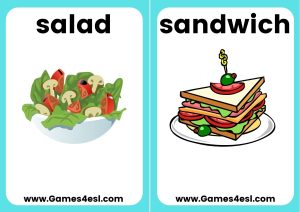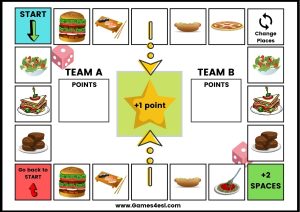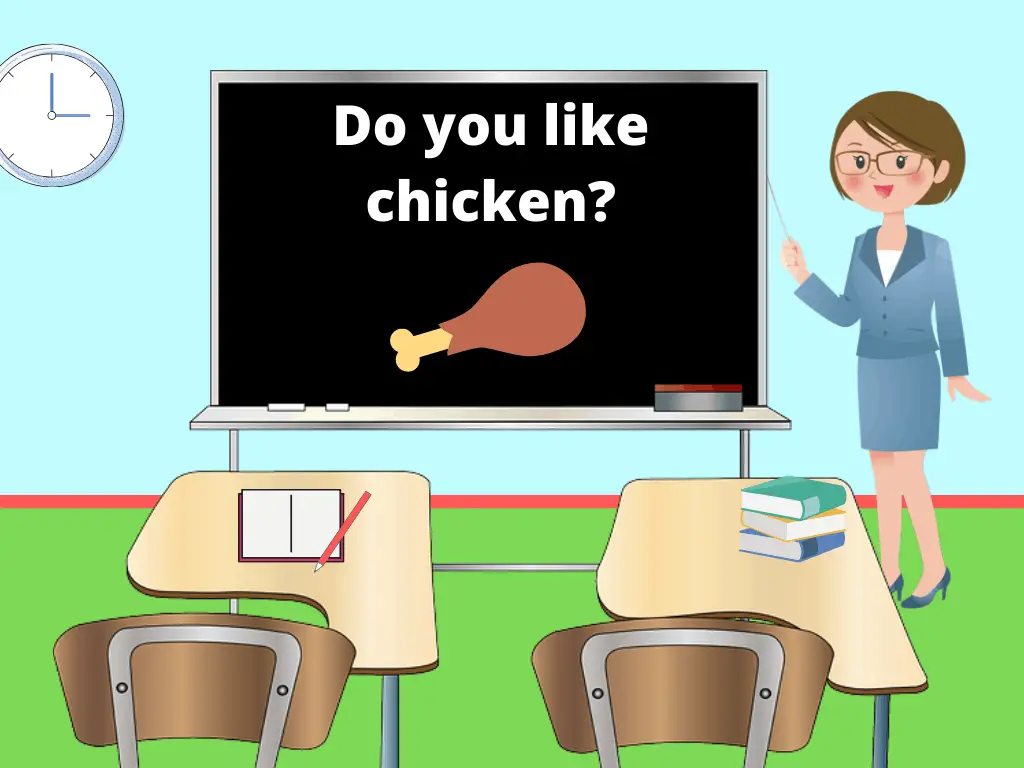Food – A Complete ESL Lesson Plan for Beginners
Food is something everyone can relate to. Learning vocabulary about food will enable students to talk about their likes and dislikes and many other things.
This page is a complete ESL lesson plan to teach food vocabulary and expressions to beginner English language learners. In this lesson, students will learn how to talk about what food they like and don’t like. This lesson can, however, be adapted to use with other expressions to do with food. All the materials for the activities in this lesson can be downloaded below.
Materials for this lesson:
Food Lesson Plan for Beginner ESL Students
Introduction and Warm Up
A great way to start your lesson about food is to play a fun food guessing game. This ‘Hidden Picture’ game from Games4esl is perfect for introducing food vocabulary. Simply play the video in class and ask students to try to guess what the food is.
If they don’t know the English word at this point, it’s okay for them to use their native language. The purpose of this activity is just to introduce the topic in a fun way and to activate students’ existing knowledge about food and food vocabulary.
Next, ask students about what other food they know in English and write those words on the board. Once you have a few examples on the board, survey the whole class as to whether or not they like those foods.
To do this, you can simply ask students to show a thumbs up or thumbs down to indicate if they like or dislike the food. This will help to put the lesson about likes and dislikes into context so students can better understand the lesson’s key expressions.
Practice Keywords And Sentences

Using these food flashcards, practice the keywords by showing the flashcards and asking students to repeat after you. Then, ask students to try to say the words on their own. Once students have practiced enough, drill some more with the key expressions.
The key sentences we will use in this lesson plan are ‘Do you like (salad)?’ – ‘Yes, I do. / No, I don’t.’. You can, of course, use the activities in this lesson plan with different expressions. Here are some other example sentences about food you might want to use:
- I like/don’t like (chicken).
- What’s your favorite food? – My favorite food is (pizza).
- What do you want to eat? – I want (salad), please.
- Do you want some more (pizza)? – Yes, please. / No, thanks.
Activity 1: Line Bingo – Listening Activity

Before the class, print out and cut these food student cards. Give one set of cards to each student or pair of students. Next, ask students to place the cards in a horizontal line in any order they wish. Once students have made a line with their cards, the line bingo game can begin.
To play this game, the teacher must choose one of the foods and then say that word out loud while using the key expression. For example, if the teacher chooses the ‘steak’ card, he/she would say, ‘Do you like (steak)?’. Then, students must look at their cards and find where the steak flashcard is. If it is on the left or right end of the line of cards, then the students turn it over and say, ‘Yes, I do.’
If the card is in the middle of the line, they don’t turn it over and must say, ‘No, I don’t.’ The aim of the game is to turn over all the cards. The first student to turn over all the cards has bingo and is the winner. This activity is a wonderful listening game and students, especially kids, love it.
You can play this game with many different topics. For more printable mini-flashcards on many topics, click here.
Activity 2: Board Game – The Dice Game

This printable board game is best played in pairs and is designed to get your students to speak about what food they like or don’t like. Each pair of students needs one board game and one dice to play. To begin, students should place their eraser on the ‘Start’ square.
Then one student should roll the dice and move his/her eraser. If they land on one of the food pictures, then the students should make a dialogue based on that picture. For example, if a student lands on the pizza picture, then he/she should ask their partner, ‘Do you like pizza?’, and their partner can answer, ‘Yes, I do. / No, I don’t.
The aim of the game is to get to the center star to win a point. The only way to get to the center star is to land on the middle squares (the ones with the arrows). After arriving at the middle star, the student gets one point and then moves his/her eraser back to the start. Stop the game after 10 minutes or so, and the student with the most points is the winner.
Activity 3: The Spy Game
This final activity is a fun speaking game that will get your students out of their seats and talking with their friends. In this activity, students must find a partner who has the same card. But, students must be careful because their partner may be a spy!
HOW TO PLAY:
First, prepare the cards for the game. In this game, students will find their partner, so you must make sure that there are enough pairs of cards for this to be possible. For example, if you have 16 students in your class, then you need 8 pairs. You can use the same student cards that were used in the line bingo game above.
Next, give each student one card and tell them that they are not allowed to show their card to anyone else. Then, tell students they must find a partner with the same card as them without showing their card.
To do this, students will walk around and ask each other, ‘Do you like…?’ and answer, ‘Yes, I do. / No, I don’t.’. For example, a student who has a ‘pizza’ card would ask a classmate, ‘Do you like pizza?’. If their classmate has the same card, they would answer, ‘Yes, I do.’. If the card is different, they would answer, ‘No, I don’t.’
Once a student has found their partner, they should go to the teacher and then show their cards to the teacher. After practicing ‘find your partner’ one or two times, it’s time to introduce a ‘spy’ card. On one of the cards, write the word ‘spy’ and then hand out the cards to the students.
Again, remind students not to show their cards to anyone else. Tell the students that if they have the ‘spy’ card, then they can lie about what card they have. The spy’s job is to try to make a partner with anyone. The other students should try to find their partner without becoming a partner with the spy.
Kids really enjoy this game, especially if they get to be the spy. After playing one or two times, you can introduce more spies to make it even more fun.
Review
Before finishing the class, review the food vocabulary and expressions that they have learned. A great way to do this is with a fun drawing game. Draw a food that you like on the board and ask students to guess what it is.
To guess, students can ask the teacher, ‘Do you like (pizza)?’. When a student guesses correctly, invite that student to come to the front to draw food that he/she likes. Again, the other students should try to guess what food is drawn on the board by asking the student, ‘Do you like (fish)?’.


